Influence of Climate Change on the Probability of Chloride-Induced Corrosion Initiation for RC Bridge Decks Made of Geopolymer Concrete
Abstract
:1. Introduction
2. Materials and Methods
2.1. Materials
- Concrete composition: The GPC mixture used in this study consists of 50% FA and 50% SG. This specific combination was chosen because it provides an optimal balance of mechanical and durability properties, which are essential for resisting chloride-induced corrosion. The inclusion of FA contributes to the long-term strength of concrete, whereas SG imparts high early strength and durability, which are critical for the structural performance of bridge decks exposed to varying temperature and humidity conditions. This combination also aligns with sustainable construction practices by utilizing industrial byproducts, thereby reducing the carbon footprint and supporting environmental sustainability goals. The material properties used are as follows:
- Chloride concentration: The mean chloride concentration applied on the top part of the RC deck is 6 kg/m3, which follows a lognormal distribution with a coefficient of variation of 30%.
- Concrete cover depth: Various concrete cover mean thicknesses are considered in the study, including 30 mm, 40 mm, 50 mm, and 60 mm.
- Chloride threshold level (Cth): The chloride threshold level, which represents the concentration at which corrosion of the reinforcing steel begins, is set at 0.7 kg/m3. This threshold level also follows a lognormal distribution with a coefficient of variation of 20%.
- Chloride diffusion coefficient (D): The apparent chloride diffusion coefficient for the specific GPC used in the study is 2.38 × 10−12 m2/s, with an age factor of 0.604.
- Temperature and humidity: The impact of varying maximum temperatures (from 25 °C to 45 °C) and relative humidity levels (70% and 75%) on the probability of corrosion initiation.
2.2. Methods
- Data collection and calculation: This study collected data on the projected maximum temperature for Toronto City and the relative humidity. The chloride diffusion coefficient over time and the chloride concentration data were determined through detailed calculations.
- Monte Carlo simulation model development: The MCS method is a key component of this study and is used to predict the PCI in RC structures under various environmental scenarios. This probabilistic approach is ideal for modeling complex systems with inherent uncertainties by simulating a wide range of possible outcomes based on input data.
- Key variables: The simulation incorporates variables such as the maximum temperature, relative humidity, concrete cover thickness, chloride concentration, and chloride diffusion coefficient. These variables are treated as random inputs to reflect the natural variability and uncertainty of real-world conditions. Each variable follows a specific statistical distribution, ensuring that the simulations capture a realistic range of potential scenarios.
- Simulation process and iteration: The MCS process is conducted to generate random samples from the input distributions. The model will then calculate the predicted PCI for each sample, and the simulation will repeat this process 100,000 times to generate an accurate result, ultimately enabling a comprehensive investigation of potential outcomes.
- Analytical evaluation: The results of the MCS are analyzed to determine the PCI for each scenario. The analysis will include statistical measures such as the mean, standard deviation, coefficient of variation, and distribution for each random variable.
- Prediction and comparison: Finally, polynomial functions would be deduced via the least squares method between the data points plotted on the x-axis and y-axis to predict the PCI and the reliability index as a function of various coefficients of variation for mean concrete covers of 40 mm and 50 mm used in RC deck made of GPC exposed to maximum temperature values of 30 °C and 40 °C applied on the top part of the deck. In addition, the mean chloride diffusion coefficient corresponds to the RC bridge deck made of GPC consisting of 50% FA and 50% SG. A comparative study was conducted to assess the impact of maximum temperature values applied on the top part of two RC decks, made of GPC and normal concrete, on the PCI to choose the optimum material for RC decks with less PCI (almost zero values of PCI) in different years.
3. Results
3.1. Calculation of the Chloride Diffusion Coefficient over Time
3.2. Temperature Projections for Toronto City across Various RCPs
3.3. Chloride-Induced Corrosion Initiation: Performance Function
3.4. Determination of the Corrected Chloride Diffusion Coefficient (Dc(t))
3.5. Validation of the Probabilistic Chloride-Induced Corrosion Initiation Model
4. Discussion of Results
4.1. Impact of Various Coefficients of Variation for Various Concrete Cover Mean Depths on the PCI for RC Bridge Decks Made of GPC (50% FA and 50% SG)
- A concrete cover of 30 mm and 40 mm used in the RC bridge deck made of GPC (50% FA and 50% SG) led to a sharp increase in the PCI when the coefficient of variation changed from 10% to 45% for both the 30 mm and 40 mm CVs.
- As the CV increased beyond 50 mm for the RC bridge deck made of GPC, there was a marked reduction in the PCI across various coefficients of variation for a mean CV of 50 mm, confirming the protective effect of a thicker concrete layer that can resist the impact of climate change.
4.2. Impact of Maximum Temperature and Relative Humidity on the PCI across Diverse Concrete Covers Used in RC Bridge Decks Made of GPC
4.3. Comparison Study between the Impacts of Two Types of RC Bridge Decks Subjected to Various Mean Maximum Temperature Levels on the PCI
5. Conclusions
- Concrete cover impact: RC bridge decks with 30 mm and 40 mm concrete covers made of GPC composed of 50% FA and 50% SG present a high risk of chloride-induced corrosion initiation when exposed to 6 kg/m3 chloride. Increasing the concrete cover to greater than 50 mm significantly reduces the PCI, highlighting the protective effect of a thicker concrete layer against climate change impacts.
- Temperature influence: The study demonstrated that maximum temperatures ranging from 40 °C to 45 °C, representing a high-emission scenario (RCP8.5), sharply increased the PCI values compared with temperatures between 25 °C and 35 °C (low-emission scenario, RCP2.6). For a concrete cover of 50 mm, the high-temperature scenario has a severe impact on the PCI, especially when the coefficient of variation for the concrete cover exceeds 30%. The impact of a maximum temperature of 40 °C on the chloride diffusion coefficient significantly increased the PCI from 3% to 33% and from 17% to 45% when the coefficients of variation changed from 10% to 45% for a mean concrete cover of 40 mm in years 50 and 100, respectively. Similarly, the PCI values also increased significantly from 0.014% to 17% and from 0.5% to 27% when the coefficients of variation changed from 10% to 45% for a mean concrete cover value of 50 mm in years 50 and 100, respectively.
- Geopolymer Concrete Benefits: This research confirmed that the use of GPC composed of 50% FA and 50% SG significantly inhibited chloride-induced corrosion initiation compared with that of normal concrete at various maximum temperatures. These findings underscore the potential of GPC as a sustainable and durable alternative to traditional Portland cement concrete.
- Relative humidity impact: The influence of relative humidity on the PCI is negligible compared with the significant impact of the maximum temperature. RH values of 70% and 75% have minimal effects on the PCI for a concrete cover of 50 mm.
- Polynomial equations: This study provides polynomial equations for predicting the PCI and reliability index (RI) across various coefficients of variation for concrete covers of 40 mm and 50 mm at different maximum temperatures. These equations serve as valuable tools for assessing the risk of chloride-induced corrosion under various climate conditions.
Author Contributions
Funding
Data Availability Statement
Conflicts of Interest
References
- Uhlig, H. Corrosion, and Corrosion Control; John Wiley & Sons Inc.: Hoboken, NJ, USA, 1963; Volume 67. [Google Scholar] [CrossRef]
- Hansson, C.M. An introduction to corrosion of engineering materials. In Corrosion of Steel in Concrete; Elsevier: Amsterdam, The Netherlands, 2016. [Google Scholar] [CrossRef]
- Revie, R.W.; Uhlig, H.H. Corrosion, and Corrosion Control: An Introduction to Corrosion Science and Engineering; John Wiley & Sons: Hoboken, NJ, USA, 2008; ISBN 9780470277270. [Google Scholar] [CrossRef]
- Mehta, P.K.; Monteiro, P.J.M. Concrete Microstructure, Properties and Materials; McGraw Hill Professional: New York, NY, USA, 2006; Volume 10, pp. 177–178. [Google Scholar]
- Qu, F.; Zhang, J.; Liu, G.; Zhao, S. Experimental Study on Chloride Ion Diffusion in Concrete Affected by Exposure Conditions. Materials 2022, 15, 2917. [Google Scholar] [CrossRef] [PubMed]
- Bier, T.; Kropp, J.; Hilsdorf, H. Formation of silica gel during carbonation of cementitious systems containing slag cement. In Proceedings of the 3rd International Conference Fly Ash, Silica Fume, Slag and Natural Pozzolans in Concrete, Trondheim, Norway, 18–23 June 1989; American Concrete Institute: Farmington Hills, MI, USA, 1989. [Google Scholar]
- Balestra, C.E.T.; Reichert, T.A.; Pansera, W.A.; Savaris, G. Evaluation of chloride ion penetration through concrete surface electrical resistivity of field naturally degraded structures present in marine environment. Constr. Build. Mater. 2020, 230, 116979. [Google Scholar] [CrossRef]
- Han, B.; Song, Z.; Zhang, J.; Xie, H.; Yan, W.; Liu, Y.; Yu, J. Coupled Effect of Chloride Corrosion and Repeated Uniaxial Compressive Loading on Unsaturated Concrete. Materials 2023, 16, 2947. [Google Scholar] [CrossRef] [PubMed]
- Tuutti, K. Corrosion of Steel in Concrete. Ph.D. Thesis, Division of Building Materials, Swedish Cement and Concrete Research Institute, Stockholm, Sweden, 1982; p. 469. [Google Scholar]
- López, W.; González, J. Influence of the degree of pore saturation on the resistivity of concrete and the corrosion rate of steel reinforcement. Cem. Concr. Res. 1993, 23, 368–376. [Google Scholar] [CrossRef]
- Andrade, C.; Alonso, C. Durability design based on models for corrosion rates. In The Modelling of Microstructure and Its Potential for Studying Transport Properties and Durability; Springer: Dordrecht, The Netherlands, 1996; pp. 473–492. [Google Scholar]
- Al-Sulaimani, G.J.; Kaleemullah, M.; Basunbul, I.A.; Rasheeduzzafar. Influence of Corrosion and Cracking on Bond Behavior and Strength of Reinforced Concrete Members. ACI Struct. J. 1990, 87, 220–231. [Google Scholar] [CrossRef]
- Cabrera, J.G.; Ghoddoussi, P. The Effect of Reinforcement Corrosion on the Strength of the Steel/Concrete Bond. In Proceedings of the International Conference Bond in Concrete from Research to Practice: Proceedings Topics, Riga, Latvia, 15–17 October 1992; CEB: Mumbai, India, 2001; pp. 11–24. [Google Scholar]
- Amleh, L.; Mirza, S. Corrosion Influence on Bond between Steel and Concrete. ACI Struct. J. 1999, 96, 415–423. [Google Scholar] [CrossRef]
- Amleh, L.; Ghosh, A. Modeling the effect of corrosion on bond strength at the steel–concrete interface with finite-element analysis. Can. J. Civ. Eng. 2006, 33, 673–682. [Google Scholar] [CrossRef]
- Ramani, V.; Zhang, L. Impacts of climate change on long-term reliability of reinforced concrete structures due to chloride ingress. Constr. Build. Mater. 2022, 354, 129091. [Google Scholar] [CrossRef]
- De Medeiros-Junior, R.A.; de Lima, M.G.; de Medeiros, M.H.F. Service life of concrete structures considering the effects of temperature and relative humidity on chloride transport. Environ. Dev. Sustain. 2014, 17, 1103–1119. [Google Scholar] [CrossRef]
- Gao, X.-J.; Wang, X.-Y. Impacts of Global Warming and Sea Level Rise on Service Life of Chloride-Exposed Concrete Structures. Sustainability 2017, 9, 460. [Google Scholar] [CrossRef]
- Lothenbach, B.; Scrivener, K.; Hooton, R. Supplementary cementitious materials. Cem. Concr. Res. 2011, 41, 1244–1256. [Google Scholar] [CrossRef]
- Thomas, M.; Hooton, R.; Scott, A.; Zibara, H. The effect of supplementary cementitious materials on chloride binding in hardened cement paste. Cem. Concr. Res. 2012, 42, 1–7. [Google Scholar] [CrossRef]
- Core Writing Team; Pachauri, R.K.; Reisinger, A. (Eds.) IPCC, (2007): Climate Change 2007: Synthesis Report, Contribution of Working Groups I, II, and III to the Fourth Assessment Report of the Intergovernmental Panel on Climate Change; IPCC: Geneva, Switzerland, 2007; ISBN 92-9169-122-4. Available online: https://www.ipcc.ch/site/assets/uploads/2018/02/ar4_syr_full_report.pdf (accessed on 31 August 2023).
- Andrade, C.; Castillo, A. Evolution of reinforcement corrosion due to climatic variations. Mater. Corros. 2003, 54, 379–386. [Google Scholar] [CrossRef]
- Yuan, Y.; Jiang, J. Prediction of temperature response in concrete in a natural climate environment. Constr. Build. Mater. 2011, 25, 3159–3167. [Google Scholar] [CrossRef]
- Models for Environmental Actions on Concrete Structures: DuraCrete, Probabilistic Performance Based Durability Design of Concrete Structures, 1st ed. The European Union-Brite EuRam III; Europe. 1999. Available online: https://lib.ugent.be/catalog/rug01:001386858 (accessed on 24 July 2024).
- Bastidas-Arteaga, E.; Chateauneuf, A.; Sánchez-Silva, M.; Bressolette, P.; Schoefs, F. Influence of weather and global warming in chloride ingress into concrete: A stochastic approach. Struct. Saf. 2010, 32, 238–249. [Google Scholar] [CrossRef]
- Yuan, Q.; Shi, C.; De Schutter, G.; Audenaert, K. Effect of temperature on the transport of chloride ions in concrete. In Concrete Repair, Rehabilitation and Retrofitting II; CRC Press: Boca Raton, FL, USA, 2008; pp. 159–160. [Google Scholar]
- Saetta, A.V.; Scotta, R.V.; Vitaliani, R.V. Analysis of chloride diffusion into partially saturated concrete. ACI Mater. J. 1993, 90, 441–451. [Google Scholar]
- Zhang, J.; Gao, Y.; Han, Y. Interior Humidity of Concrete under Dry-Wet Cycles. J. Mater. Civ. Eng. 2012, 24, 289–298. [Google Scholar] [CrossRef]
- Ali, M.S.; and Mirza, M.S. Impact of Climate Change on Civil Infrastructure—A State-of-the-Art Review. In Proceedings of the EIC Climate Change Technology Conference 2015, Montreal, QC, Canada, 25–27 May 2015. [Google Scholar]
- Core Writing Team; Pachauri, R.K.; Meyer, L. (Eds.) IPCC 2014: Climate Change 2014: Synthesis Report, Contribution of Working Groups I, II, and III to the Fifth Assessment Report of the Intergovernmental Panel on Climate Change; IPCC: Geneva, Switzerland, 2015; Available online: https://epic.awi.de/id/eprint/37530/1/IPCC_AR5_SYR_Final.pdf (accessed on 31 August 2023)ISBN 978-92-9169-143-2.
- Saassouh, B.; Lounis, Z. Probabilistic modeling of chloride-induced corrosion in concrete structures using first- and second-order reliability methods. Cem. Concr. Compos. 2012, 34, 1082–1093. [Google Scholar] [CrossRef]
- Singh, N.; Middendorf, B. Geopolymers as an alternative to Portland cement: An overview. Constr. Build. Mater. 2020, 237, 117455. [Google Scholar] [CrossRef]
- Kakria, K.; Thirumalini, S.; Secco, M.; Priya, T.S. A novel approach for the development of sustainable hybridized geopolymer mortar from waste printed circuit boards. Resour. Conserv. Recycl. 2020, 163, 105066. [Google Scholar] [CrossRef]
- Shah, S.N.; Mo, K.H.; Yap, S.P.; Yang, J.; Ling, T.-C. Lightweight foamed concrete as a promising avenue for incorporating waste materials: A review. Resour. Conserv. Recycl. 2020, 164, 105103. [Google Scholar] [CrossRef]
- Amran, Y.M.; Alyousef, R.; Alabduljabbar, H.; El-Zeadani, M. Clean production and properties of geopolymer concrete; A review. J. Clean. Prod. 2020, 251, 119679. [Google Scholar] [CrossRef]
- Xu, G.; Shi, X. Characteristics and applications of fly ash as a sustainable construction material: A state-of-the-art review. Resour. Conserv. Recycl. 2018, 136, 95–109. [Google Scholar] [CrossRef]
- Rajamane, N.P.; Nataraja, M.C.; Jeyalakshmi, R.; Nithiyanantham, S. Greener durable concretes through geopolymerisation of blast furnace slag. Mater. Res. Express 2015, 2, 055502. [Google Scholar] [CrossRef]
- Wasim, M.; Roychand, R.; Barnes, R.T.; Talevski, J.; Law, D.; Li, J.; Saberian, M. Performance of Reinforced Foam and Geopolymer Concretes against Prolonged Exposures to Chloride in a Normal Environment. Materials 2023, 16, 149. [Google Scholar] [CrossRef] [PubMed]
- Yip, C.K.; Lukey, G.C.; Van Deventer, J.S.J. The coexistence of geopolymeric gel and calcium silicate hydrate at the early stage of alkaline activation. Cem. Concr. Res. 2005, 35, 1688–1697. [Google Scholar] [CrossRef]
- Amran, M.; Debbarma, S.; Ozbakkaloglu, T. Fly ash-based eco-friendly geopolymer concrete: A critical review of the long-term durability properties. Constr. Build. Mater. 2021, 270, 121857. [Google Scholar] [CrossRef]
- Meesala, C.R.; Verma, N.K.; Kumar, S. Critical review on fly-ash based geopolymer concrete. Struct. Concr. 2019, 21, 1013–1028. [Google Scholar] [CrossRef]
- Oyebisi, S.; Olutoge, F.; Kathirvel, P.; Oyaotuderekumor, I.; Lawanson, D.; Nwani, J.; Ede, A.; Kaze, R. Sustainability assessment of geopolymer concrete synthesized by slag and corncob ash. Case Stud. Constr. Mater. 2022, 17, e01665. [Google Scholar] [CrossRef]
- Shehata, N.; Mohamed, O.; Sayed, E.T.; Abdelkareem, M.A.; Olabi, A. Geopolymer concrete as green building materials: Recent applications, sustainable development and circular economy potentials. Sci. Total. Environ. 2022, 836, 155577. [Google Scholar] [CrossRef]
- Sherwani, A.F.H.; Younis, K.H.; Arndt, R.W.; Pilakoutas, K. Performance of Self-Compacted Geopolymer Concrete Containing Fly Ash and Slag as Binders. Sustainability 2022, 14, 15063. [Google Scholar] [CrossRef]
- Nagaraju, T.V.; Bahrami, A.; Azab, M.; Naskar, S. Development of sustainable high-performance geopolymer concrete and mortar using agricultural biomass—A strength performance and sustainability analysis. Front. Mater. 2023, 10, 1128095. [Google Scholar] [CrossRef]
- Manzoor, T.; Bhat, J.A.; Shah, A.H. Performance of geopolymer concrete at elevated temperature—A critical review. Constr. Build. Mater. 2024, 420, 135578. [Google Scholar] [CrossRef]
- Özkılıç, Y.O.; Çelik, A.I.; Tunç, U.; Karalar, M.; Deifalla, A.; Alomayri, T.; Althoey, F. The use of crushed recycled glass for alkali activated fly ash based geopolymer concrete and prediction of its capacity. J. Mater. Res. Technol. 2023, 24, 8267–8281. [Google Scholar] [CrossRef]
- Çelik, A.I.; Özkılıç, Y.O.; Bahrami, A.; Hakeem, I.Y. Mechanical performance of geopolymer concrete with micro silica fume and waste steel lathe scraps. Case Stud. Constr. Mater. 2023, 19, e02548. [Google Scholar] [CrossRef]
- Acar, M.C.; Çelik, A.I.; Kayabaşı, R.; Şener, A.; Özdöner, N.; Özkılıç, Y.O. Production of perlite-based-aerated geopolymer using hydrogen peroxide as eco-friendly material for energy-efficient buildings. J. Mater. Res. Technol. 2023, 24, 81–99. [Google Scholar] [CrossRef]
- Tennakoon, C.; Shayan, A.; Sanjayan, J.G.; Xu, A. Chloride ingress and steel corrosion in geopolymer concrete based on long term tests. Mater. Des. 2017, 116, 287–299. [Google Scholar] [CrossRef]
- Kayali, O.; Khan, M.; Ahmed, M.S. The role of hydrotalcite in chloride binding and corrosion protection in concretes with ground granulated blast furnace slag. Cem. Concr. Compos. 2012, 34, 936–945. [Google Scholar] [CrossRef]
- Provis, J.L.; Myers, R.J.; White, C.E.; Rose, V.; van Deventer, J.S. X-ray microtomography shows pore structure and tortuosity in alkali-activated binders. Cem. Concr. Res. 2012, 42, 855–864. [Google Scholar] [CrossRef]
- Odler, I. Hydration, setting, and hardening of Portland cement. In Lea’s Chemistry of Cement and Concrete; Elsevier: Amsterdam, The Netherlands, 1998; pp. 241–291. [Google Scholar]
- Neville, A.M. Durability of concrete. In Properties of Concrete, 5th ed.; Prentice Hall: Hoboken, NJ, USA, 1996; pp. 1350–1450. [Google Scholar]
- Leng, F.; Feng, N.; Lu, X. An experimental study on the properties of resistance to diffusion of chloride ions of fly ash and blast furnace slag concrete. Cem. Concr. Res. 2000, 30, 989–992. [Google Scholar] [CrossRef]
- Sasui, S.; Kim, G.; Nam, J.; Koyama, T.; Chansomsak, S. Strength and Microstructure of Class-C Fly Ash and GGBS Blend Geopolymer Activated in NaOH & NaOH+ Na2SiO3. Materials 2020, 13, 59. [Google Scholar] [CrossRef]
- Bush, E.; Lemmen, D.S. (Eds.) Canada Changing Climate Report; Government of Canada: Ottawa, ON, Canada, 2019.
- Alinaghimaddah, S.; Shayanfar, M.A.; Bagha, M.G. Effect of distance from the sea on reinforced concrete chloride corrosion probability. AUT J. Civ. Eng. 2020, 4, 199–208. [Google Scholar] [CrossRef]
- Hasan, M.; Amleh, L.; Othman, H. Effect of different cement content and water cement ratio on carbonation depth and probability of carbonation induced corrosion for concrete. Cem. Wapno Beton 2022, 27, 126–143. [Google Scholar] [CrossRef]
- Hassan, M.; Amleh, L. Influence of Climate Change on Probability of Carbonation-Induced Corrosion Initiation. Period. Polytech. Civ. Eng. 2023, 68, 57–67. [Google Scholar] [CrossRef]
- Kroese, D.P.; Brereton, T.; Taimre, T.; Botev, Z.I. Why the Monte Carlo method is so important today. WIREs Comput. Stat. 2014, 6, 386–392. [Google Scholar] [CrossRef]
- Choi, S.K.; Grandhi, R.V.; Canfield, R.A. Reliability-Based Structural Design; Springer: New York, NY, USA, 2007. [Google Scholar]
- Sobol, I.M. A Primer for the Monte Carlo Method; CRC Press: Boca Raton, FL, USA, 1994. [Google Scholar]
- Kalos, M.H.; Whitlock, P.A. Monte Carlo Methods, 2nd ed.; John Wiley and Sons: New York, NY, USA, 2008. [Google Scholar]
- Neville, A. Chloride attack of reinforced concrete: An overview. Mater. Struct. 1995, 28, 63–70. [Google Scholar] [CrossRef]
- Cady, P.; Weyers, R. Chloride Penetration and the Deterioration of Concrete Bridge Decks. Cem. Concr. Aggregates 1983, 5, 81–87. [Google Scholar] [CrossRef]
- Costa, A.; Appleton, J. Chloride penetration into concrete in marine environment—Part I: Main parameters affecting chloride penetration. Mater. Struct. 1999, 32, 252–259. [Google Scholar] [CrossRef]
- Tongaria, K.; Mandal, S.; Mohan, D. A Review on Carbonation of Concrete and Its Prediction Modelling. J. Environ. Nanotechnol. 2018, 7, 75–90. [Google Scholar] [CrossRef]
- Baccay, M.A.; Otsuki, N.; Nishida, T.; Maruyama, S. Influence of Cement Type and Temperature on the Rate of Corrosion of Steel in Concrete Exposed to Carbonation. Corrosion 2006, 62, 811–821. [Google Scholar] [CrossRef]
- DuraCrete. Statistical quantification of the variables in the limit state functions. Contract BRPR-CT95-0132. Project BE95-1347/R9. 2000. Available online: https://www.scirp.org/reference/referencespapers?referenceid=766310 (accessed on 24 July 2024).
- Page, C.; Short, N.; El Tarras, A. Diffusion of chloride ions in hardened cement pastes. Cem. Concr. Res. 1981, 11, 395–406. [Google Scholar] [CrossRef]
- Bažant, Z.; Najjar, L. Drying of concrete as a nonlinear diffusion problem. Cem. Concr. Res. 1971, 1, 461–473. [Google Scholar] [CrossRef]
- Nowak, A.S. Calibration of LRFD Bridge Design Code. National Cooperative Highway Research Program; NCHRP Report 368; Transportation Research Board: Washington, DC, USA, 1999. [Google Scholar]
- Benjamin, J.R.; and Cornell, C.A. Probability, Statistics, and Decision for Civil Engineers; McGraw-Hill: New York, NY, USA, 1970. [Google Scholar]
- Lounis, Z.; Saassouh, B.; Zhang, J. Probability-Based Modeling of Chloride-Induced Corrosion in Concrete Structures Including Parameters Correlation. In Proceedings of the Applications of Statistics and Probability in Civil Engineering, NRCC-53612 1206-1212, Zurich, Switzerland, 1–4 August 2011; National Research Council Canada: Ottawa, ON, Canada, 2011. [Google Scholar]
- Chidiac, T.J.; Ukrainczyk, N.; Prentice, D.P.; Provis, J.L. Probabilistic Service Life Prediction of Alkali Activated Concretes Exposed to Chloride Induced Corrosion. J. Adv. Concr. Technol. 2023, 21, 1020–1035. [Google Scholar] [CrossRef]
- Bentz, E.C. Probabilistic Modeling of Service Life for Structures Subjected to Chlorides. ACI Mater. J. 2003, 100, 391–397. [Google Scholar] [CrossRef]
- Berke, N.S.; Hicks, M.C. Predicting Chloride Profiles in Concrete. Corrosion 1994, 50, 234–239. [Google Scholar] [CrossRef]
- Amey, S.; Johnson, D.; Miltenberger, M.; Farzam, K. Predicting the Service Life of Concrete Marine Structures: An Environmental Methodology. ACI Struct. J. 1998, 95, 205–214. [Google Scholar] [CrossRef]
- Weyers, R.; Prowell, B.; Sprinkel, M.; Vorster, M. Concrete bridge protection, repair, and rehabilitation relative to reinforcement corrosion: A methods application manual. Contract 1993, 100, 103. [Google Scholar]



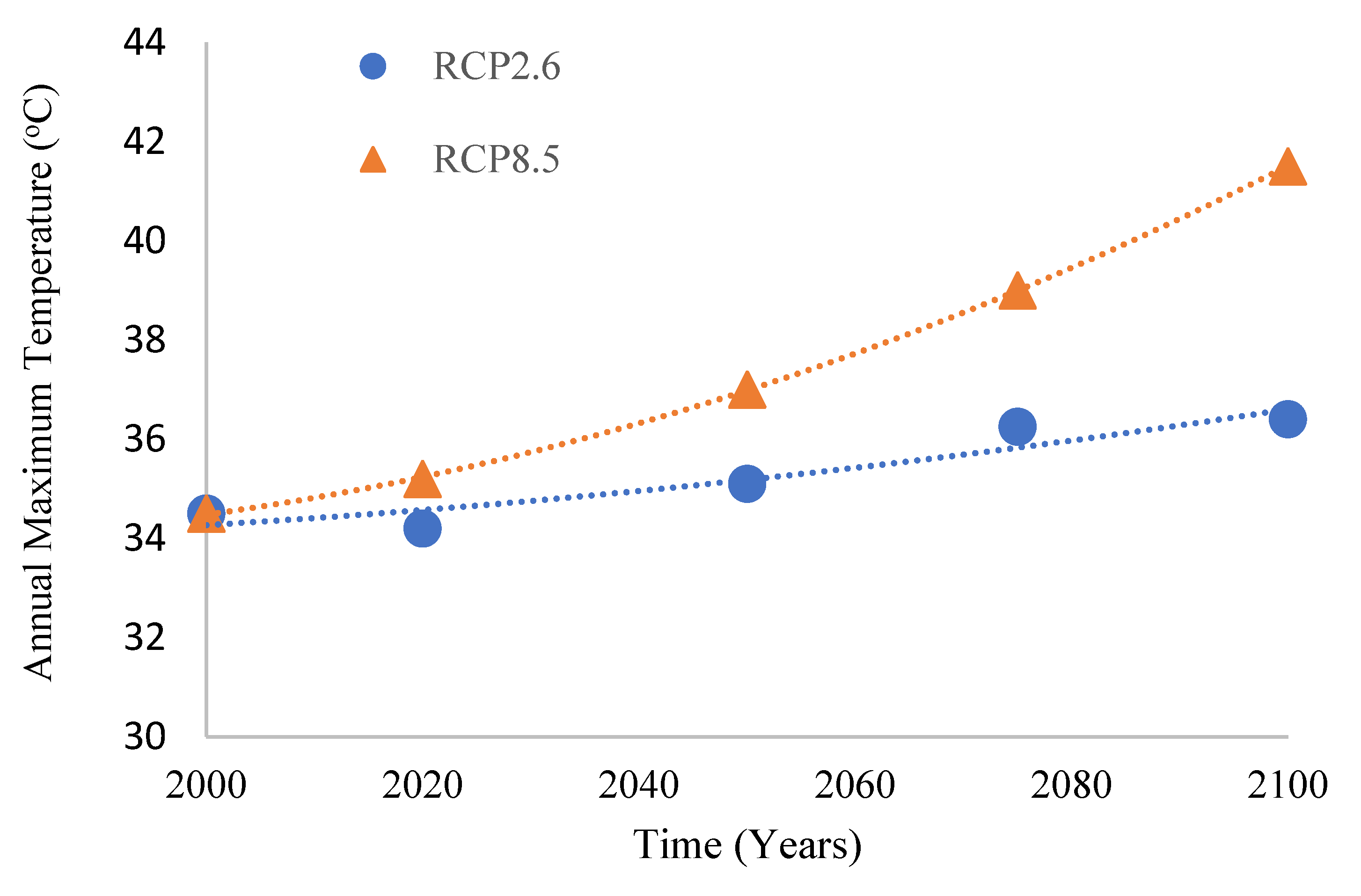
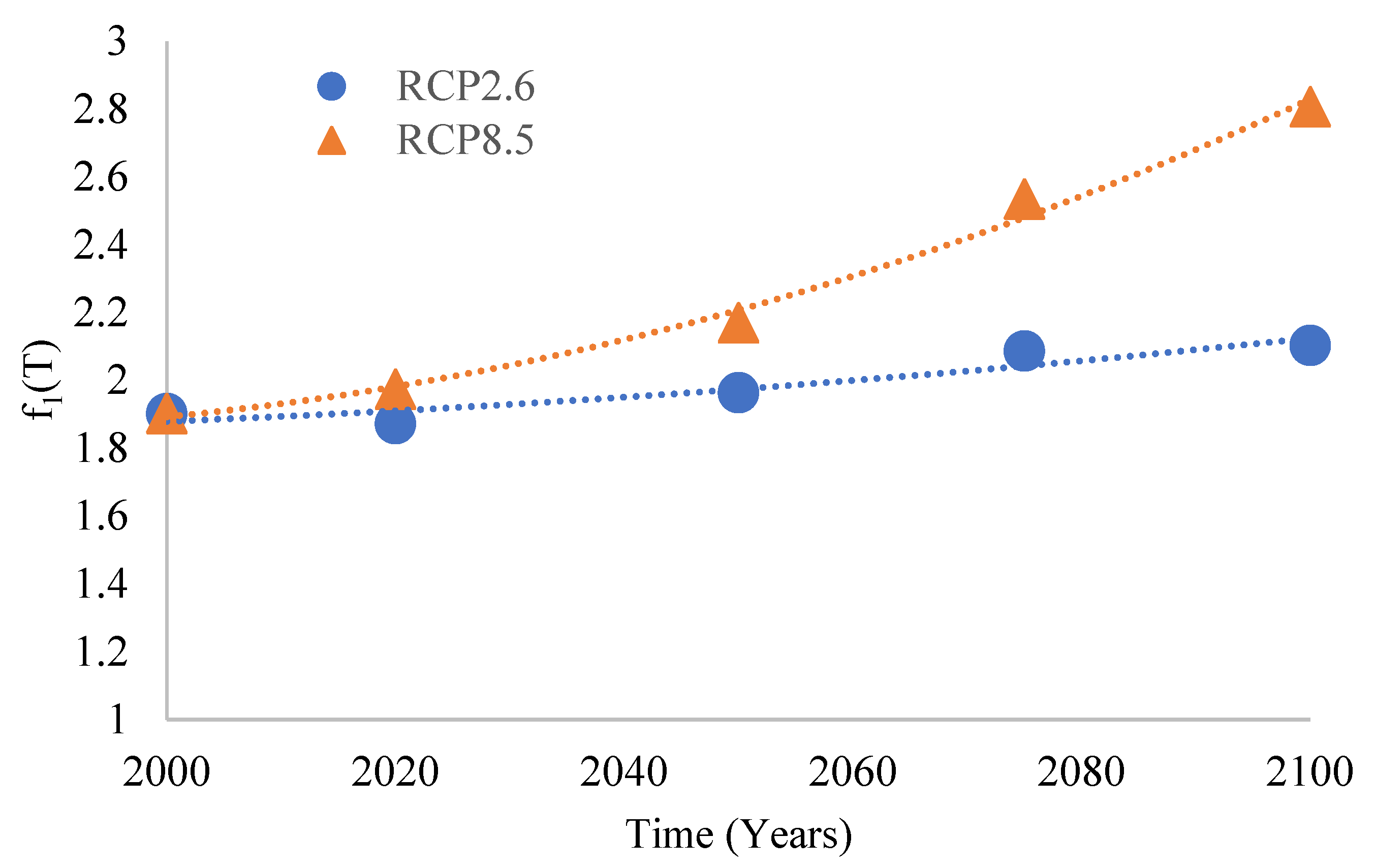



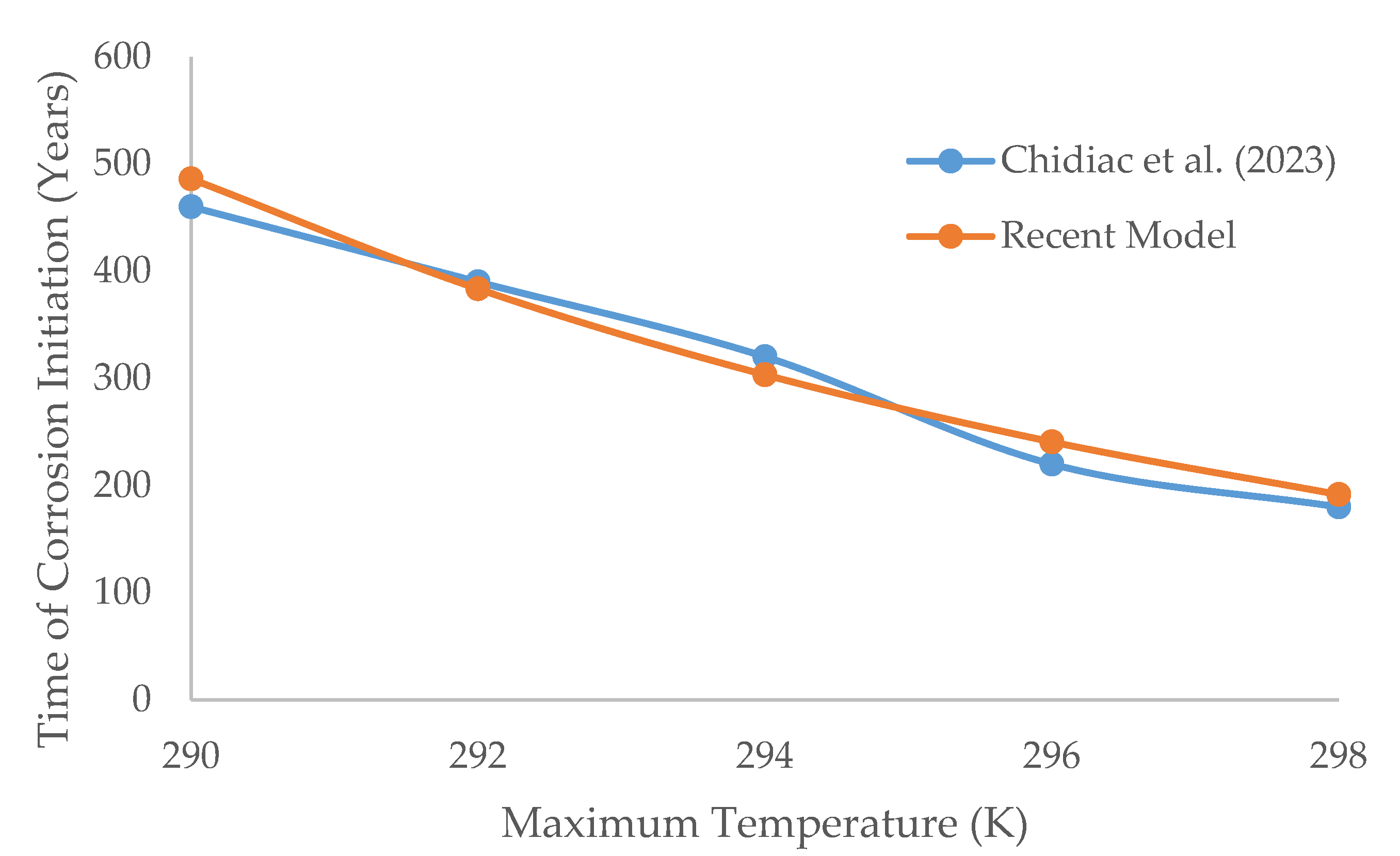


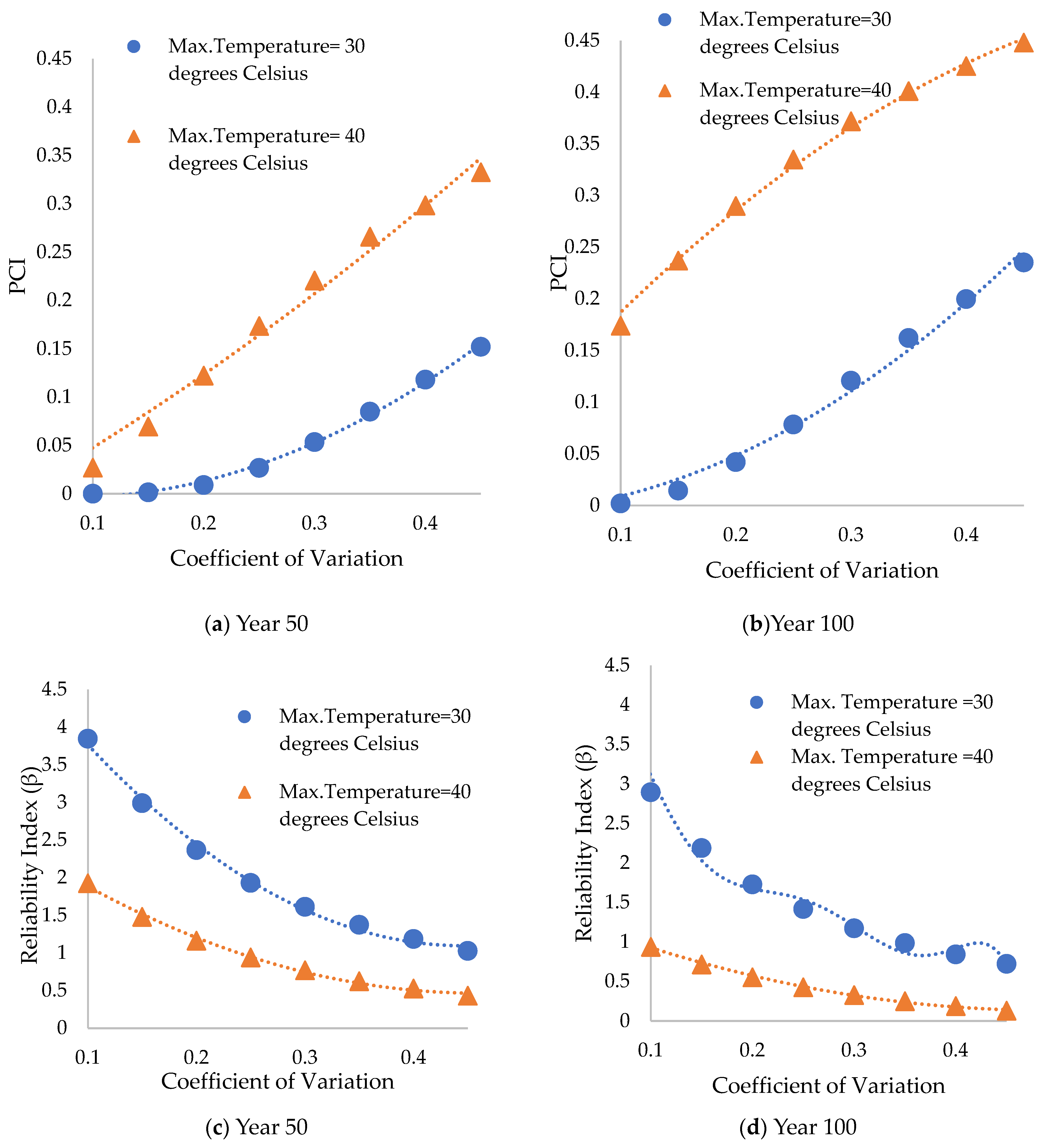
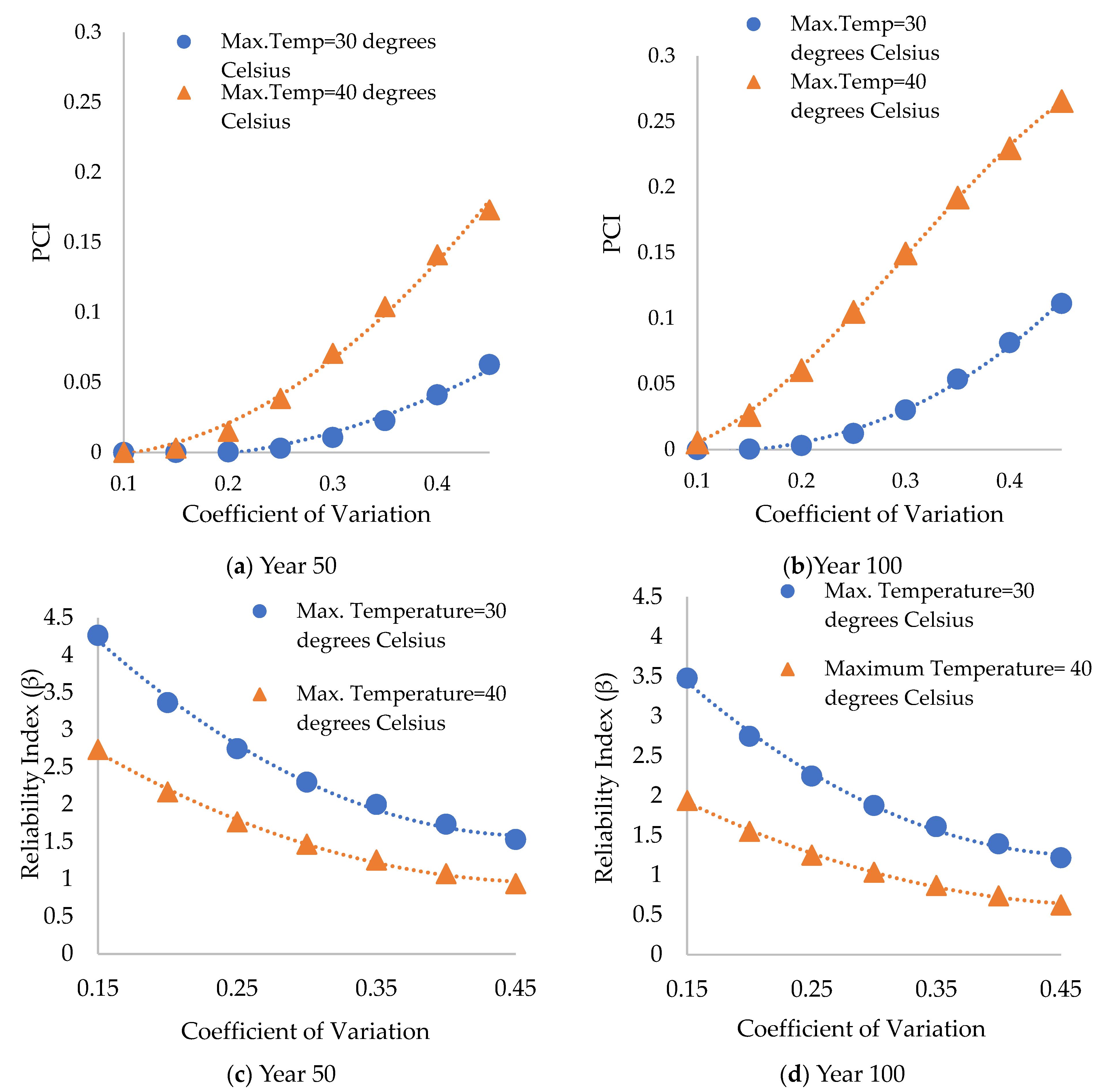



| Random Variables | Mean Value (μ) | Coefficient of Variation (COV) | Distribution |
|---|---|---|---|
| Chloride Concentration (Co) (kg/m3) | 6 | 30% | Log-normal |
| Concrete Cover (x) (mm) | 70 | 20% | |
| Chloride threshold (Cth) (kg/m3) | 0.7 | 20% |
| Parameters | Mean | COV (%) | Distribution |
|---|---|---|---|
| Cth (kg/m3) | 0.7 | 20% | Lognormal |
| Co (kg/m3) | 6 | 30% | Lognormal |
| D (t) (m2/s) | 4.75 × 10−14 (50 years) 3.13 × 10−14 (100 years) | --------- | Deterministic |
| Year | Maximum Temperature = 30 °C | Maximum Temperature = 40 °C |
|---|---|---|
| 50 | PCI = (1.1449 × (COV)2) − 0.1767 × (COV) + 0.0027 (R2 = 0.997) | PCI = −5.9616 × (COV)3 + 4.4211 × (COV)2 − 0.0488 × (COV) − 0.0015 (R2 = 0.999) |
| 100 | PCI = 1.1526 × (COV)2 + 0.0475 × (COV) − 0.0074 (R2 = 0.991) | PCI = −0.9164 × (COV)2 + 1.2608 × (COV) + 0.0701 (R2 = 0.994) |
| Year | Maximum Temperature = 30 °C | Maximum Temperature = 40 °C |
|---|---|---|
| 50 | RI = 22.291 × (COV)2 − 19.89 × (COV) + 5.5324 (R2 = 0.996) | RI = 10.963 × (COV)2 − 10.077 × (COV) + 2.7814 (R2 = 0.996) |
| 100 | RI = −82,090 × (COV)6 + 125,211 × (COV)5 − 74,471 × (COV)4 + 21,684 × (COV)3 − 3142.4 × (COV)2 + 191.07 × (COV) + 0.0197 (R2 = 0.990) | RI = 5.2241 × (COV)2 − 5.1182 × (COV) + 1.3879 (R2 = 0.997) |
| Year | Maximum Temperature = 30 °C | Maximum Temperature = 40 °C |
|---|---|---|
| 50 | PCI = (1.404 × (COV)3) − (0.3555 × (COV)2) + (0.0168 × COV) + 0.0001 (R2 = 0.999) | PCI = (−1.1234 × (COV)3) + (1.942 × (COV)2) − (0.2629 × (COV)) + 0.0038 (R2 = 0.997) |
| 100 | PCI = (0.9463 × (COV)2) − 0.1907 × (COV) + 0.0047 (R2 = 0.994) | PCI = (−4.5795 × (COV)3) + (4.1012 × (COV)2) − (0.3346 × (COV)) + 0.0024 (R2 = 0.999) |
| Year | Maximum Temperature = 30 °C | Maximum Temperature = 40 °C |
|---|---|---|
| 50 | RI = 26.349 × (COV)2 − 24.529 × (COV) + 7.2879 (R2 = 0.996) | RI = 16.364 × (COV)2 − 15.594 × (COV) + 4.673 (R2 = 0.997) |
| 100 | RI = 21.037 × (COV)2 − 19.855 × (COV) + 5.9356 (R2 = 0.997) | RI = 10.974 × (COV)2 − 10.831 × (COV) + 3.2975 (R2 = 0.998) |
Disclaimer/Publisher’s Note: The statements, opinions and data contained in all publications are solely those of the individual author(s) and contributor(s) and not of MDPI and/or the editor(s). MDPI and/or the editor(s) disclaim responsibility for any injury to people or property resulting from any ideas, methods, instructions or products referred to in the content. |
© 2024 by the authors. Licensee MDPI, Basel, Switzerland. This article is an open access article distributed under the terms and conditions of the Creative Commons Attribution (CC BY) license (https://creativecommons.org/licenses/by/4.0/).
Share and Cite
Amleh, L.; Hassan, M.; Hussein, L. Influence of Climate Change on the Probability of Chloride-Induced Corrosion Initiation for RC Bridge Decks Made of Geopolymer Concrete. Sustainability 2024, 16, 8200. https://doi.org/10.3390/su16188200
Amleh L, Hassan M, Hussein L. Influence of Climate Change on the Probability of Chloride-Induced Corrosion Initiation for RC Bridge Decks Made of Geopolymer Concrete. Sustainability. 2024; 16(18):8200. https://doi.org/10.3390/su16188200
Chicago/Turabian StyleAmleh, Lamya, Mostafa Hassan, and Luaay Hussein. 2024. "Influence of Climate Change on the Probability of Chloride-Induced Corrosion Initiation for RC Bridge Decks Made of Geopolymer Concrete" Sustainability 16, no. 18: 8200. https://doi.org/10.3390/su16188200







